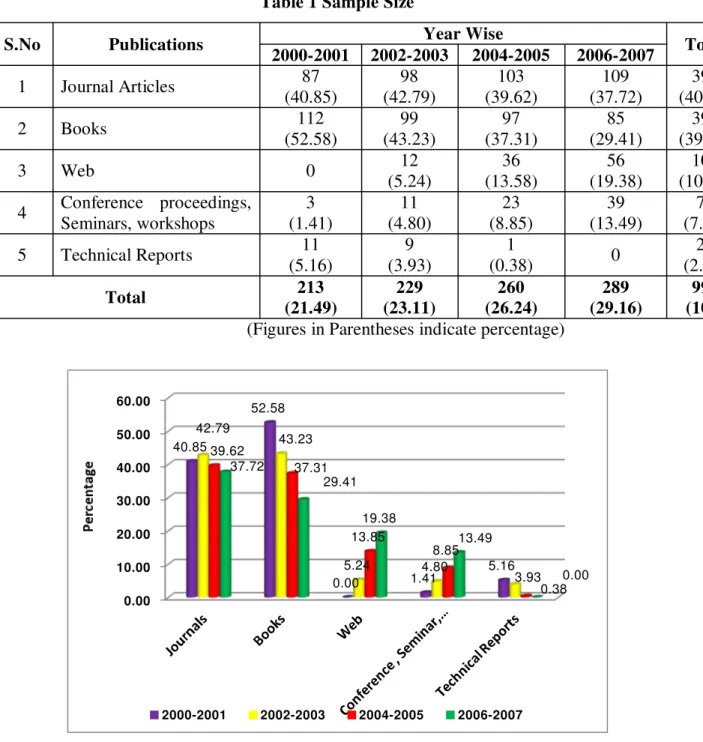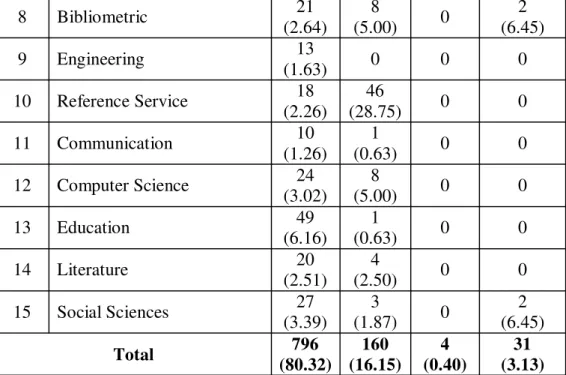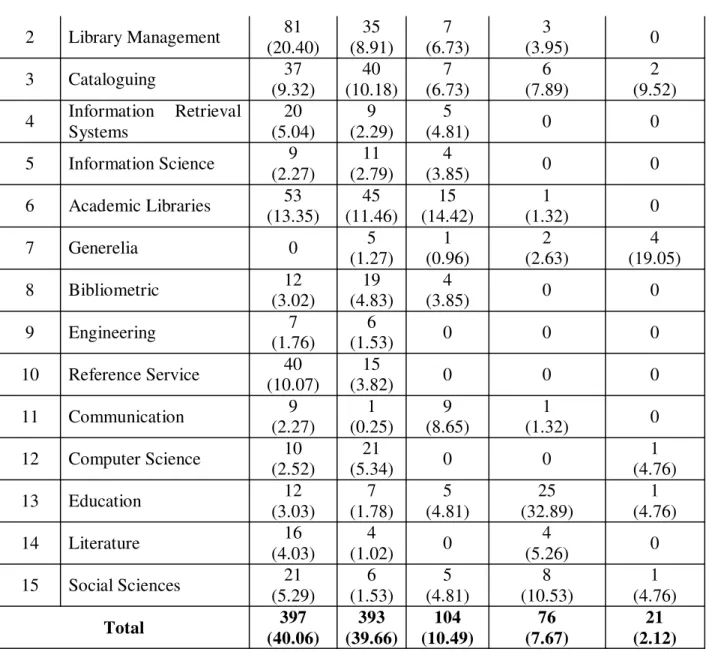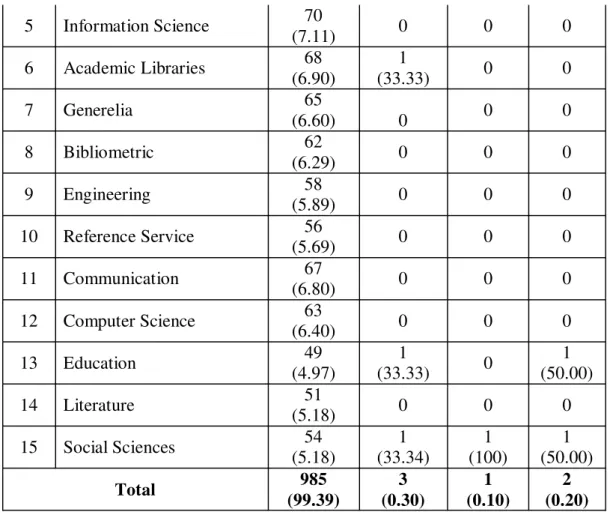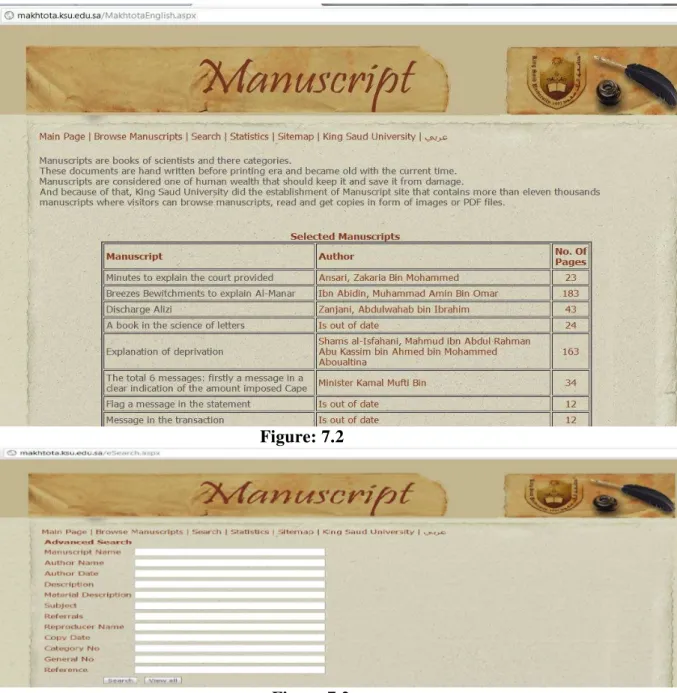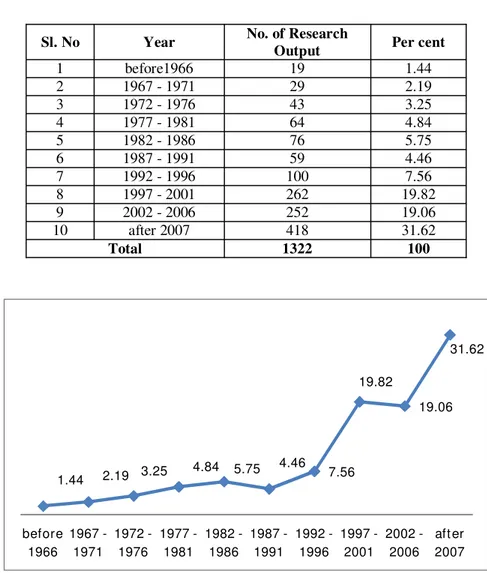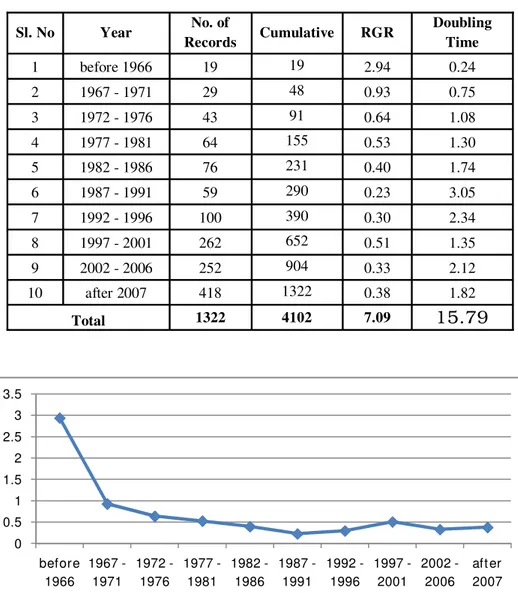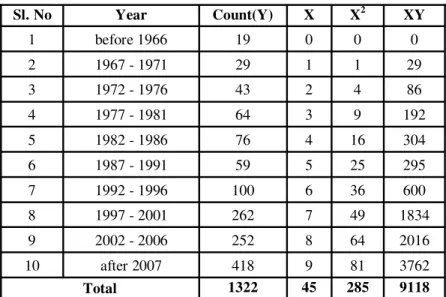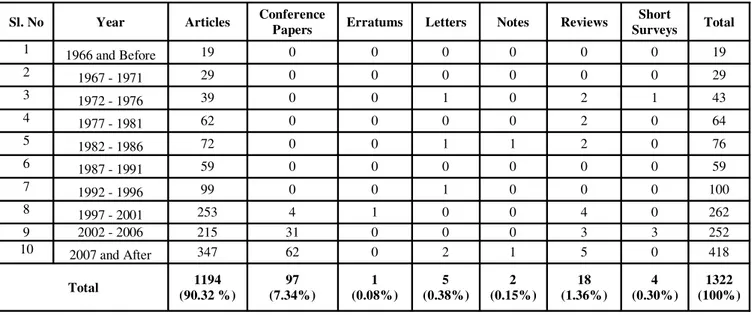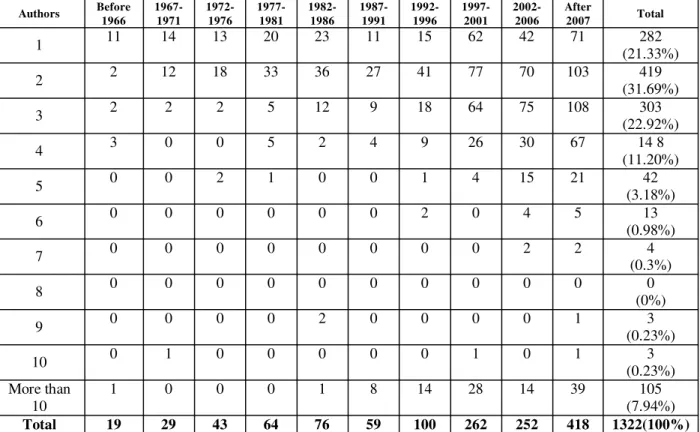44 | IIIJJJOOODDDLLLSSS
CITATION ANALYSIS OF DISSERTATIONS SUBMITTED TO THE
DEPARTMENT OF LIBRARY AND INFORMATION SCIENCE, SRI
VENKATESWARA UNIVERSITY, TIRUPATI
Dr. K.Kumar
Librarian, SVCET, Chittoor, Mail:kumarkkutty@gmail.com
T.Raghunadha Reddy
Librarian, SVCET, Chittoor, Mail:raghuthima@gmail.com
Abstract
Citations in Master’s degree dissertations submitted to the Department of Library and Information Science, Sri
Venkateswara University, Tirupathi during the period 2000 - 2007, were analysed for finding possible
relationships between citing, citing articles and bibliographic forms. Frequency and percentage distributions
(presented in charts, tables and graphs) and measures of central tendency were used to analyse data. Findings
showed that journals were the most utilized reference materials in the dissertations. Also, library science in
general had the highest number of citations followed by library management and cataloguing. The lowest
numbers of citations were from education, literature and social sciences respectively. The findings from this
study could serve as a user study with implications for collection, development and user services designing in
libraries.
Keywords: Citation, Library and Information Science, Dissertations.
Introduction
Citation analysis is a new technique used to measure quantitatively the value of document through arranging the citations in some kind of rank or order. It is also used to study the growth and structure of literature of any subject. This technique is helpful tool for the library management in the selection and weeding of materials in the face of ever expanding information environment. Citation analysis reflects on citation practices1.
45 | IIIJJJOOODDDLLLSSS They studied the citation3 frequency in the reference given in the “Journal of The American Chemical Society (Amudavalli 1977).From an application point of view, citation analysis may be considered as a collaborative peer effort to analyze and promote the quality of scholarly publication and research4. Citation analysis studies the patterns of citations in documents, an objective method for gathering data about information needs5. Williams and Fletcher6 explained citation analysis as a nonintrusive method of finding patterns in a specific population’s use of research materials. Meho7 has observed that citation analysis is actually a branch of information science in which researchers studied the way articles in a scholarly field are accessed and referenced by others. It has been used for the purpose of scholarly analysis and evaluation in several fields of human endeavour. In this study, citation analysis is employed in studying masters’ dissertations submitted to the department of library and Information science, Sri Venkateswara University, Tirupathi (2000-2008) with a view to find out citation practice in the dissertations.
Review of Literature
In his essay on citation analysis, King8 pointed out that scientists are drowning in a flood of information overload. Remarkably, thousands of scientific studies are published on a daily basis. One method for tracking and evaluating research is citation analysis. Citation analysis works because scientists leave an unmistakable trail behind them as they report their work-a trail of footnotes. Today, a scientific publication is easily recognized by its footnotes, endnotes and references to other scientific articles or books9. More citations were from the books and periodicals than the other type of materials. Similar type of study was performed by Koley10& Sen (2003) covering 457 citations appended to 26 research articles published in the four issues of the quarterly Indian Journal of Physiology and Allied Sciences. Of the citations, 76.81% relate to journal articles, 18.59% to monographs, and the rest to conference papers, theses, etc. A total of 4,012 citations in 70 postgraduate dissertations in education were studied by Okiy11 (2003). Most students in education used more textbooks (60.3 per cent), than other forms of library materials. Megnigbeto12(2006) studied the citations of dissertations of library and information science undergraduate students and found that the number of citations to Internet resources was very low.
46 | IIIJJJOOODDDLLLSSS cited format (63%). Bhat & Sampath Kumar14 (2008) describes a citation analysis of research articles from scholarly electronic journals published in 2000-2006. The analysis focused on the extent to which scholars are using web-based sources in scholarly electronic journals. Results of the study shows that 81.49% of articles published in selected 9 electronic journals during 2000-2006 have web references. Out of 25,730 references 56.54 % of references are print journal references and 43.52% of them are web references. 437 citations in 32 research articles in two issues of the RMJ were collected by Javed & Shah15 (2008). The study revealed that 49.52 % citations pertained to journal articles and rest to other resource types. All the above studies except the last one reveals that journals are heavily cited and preferred source of information. In the above studies citations of journal articles were analyzed. Other studies have analyzed the citations of Doctoral dissertations or Masters' theses come up with the following results.
Objectives
The specific objectives of the present study are to know
The distribution of citations in the major branches of library and information science. The authorship patterns
Geographic scattering of cited journals Language wise distribution of cited journals. The chronological scattering of cited periodicals
The self citing rate and subject wise break-up of cited journals
Limitation of the Study
Citation analysis like any other study is not free from criticism. The following are some of the limitations of citation.
The study is confined to the dissertations submitted to dept of library and information science for the fulfillment of M.L.I.Sc.
The study is confined to only available dissertations in library and in the department. The study is completely confined to the documentary
Citation and co-citation counts are just part of the available experimental data, thus the assigning the relative weight age to citation is objectionable keeping in view the totality of information.
Methodology
47 | IIIJJJOOODDDLLLSSS Venkateswara University, Tirupati covering the period 2000-2007. The sampling procedure for the study was purposive since data was being collected specifying the target period 2000-2007. Table1 shows that total populations of the dissertations total 91 M.L.I.Sc dissertations (991 citations) were analysed (Figure 1).
Table 1 Sample Size
S.No Publications Year Wise Total
2000-2001 2002-2003 2004-2005 2006-2007
1 Journal Articles 87
(40.85) 98 (42.79) 103 (39.62) 109 (37.72) 397 (40.06)
2 Books 112
(52.58) 99 (43.23) 97 (37.31) 85 (29.41) 393 (39.66)
3 Web 0 12
(5.24) 36 (13.58) 56 (19.38) 104 (1049). 4 Conference proceedings,
Seminars, workshops 3 (1.41) 11 (4.80) 23 (8.85) 39 (13.49) 76 (7.67)
5 Technical Reports 11
(5.16)
9 (3.93)
1
(0.38) 0
21 (2.12)
Total 213
(21.49) 229 (23.11) 260 (26.24) 289 (29.16) 991 (100)
(Figures in Parentheses indicate percentage)
Figure 1: Year Wise Publications of Citations 0.00 10.00 20.00 30.00 40.00 50.00 60.00 40.85 52.58 0.00 1.41 5.16 42.79 43.23 5.24 4.80 3.93 39.62 37.31 13.85 8.85 0.38 37.72 29.41 19.38 13.49 0.00
48 | IIIJJJOOODDDLLLSSS
Data Analysis
The data received carefully edited tabulated and analyzed. To make the data analysis statistically sound SPSS (Statistical Package for the Social Science), necessary statistical techniques (diagrams) are used.
Subject wise Distribution
The Distribution of citation appended to the Distributions of library and information science in the major branches of library and information science is shown in table 2.
Table2: Distribution of citation in subject wise
S.No. Subject No. of
Citations Percentage
1 Library Science-in-General 319 32.19
2 Library Management 126 12.71
3 Cataloguing 92 9.28
4 Information Retrieval Systems 34 3.43
5 Information Science 24 2.42
6 Academic Libraries 114 11.50
7 Generelia 25 2.52
8 Bibliometric 31 3.13
9 Engineering 13 1.31
10 Reference Service 64 6.46
11 Communication 11 1.10
12 Computer Science 32 3.23
13 Education 50 5.04
14 Literature 24 2.42
15 Social Sciences 32 3.26
Total 991 100
49 | IIIJJJOOODDDLLLSSS
Figure2: Distribution of Citation in Subject wise
Distribution of Subject wise Vs Authorship pattern
The Characteristics of subject literature consists of not only the basic publishing patterns, but also the authors.
Table3: Distribution of Subject wise Vs Authorship pattern
S.No Subject Single Double Triple
More than Three
1 Library Science-in-General 279 (35.05)
38
(23.75) 0
2 (6.45) 2 Library Management 107
(13.44) 16 (10.00) 1 (25.00) 2 (6.45)
3 Cataloguing 83
(10.43) 4 (2.5) 3 (75.00) 2 (6.45) 4 Information Retrieval
Systems
31 (3.89)
3
(1.87) 0 0
5 Information Science 15 (1.88)
6
(3.75) 0
3 (9.68) 6 Academic Libraries 89
(11.18)
22
(13.75) 0
3 (9.68)
7 Generelia 10
(1.26) 0 0
15 (48.39) 32% 13% 9% 4% 2% 13% 3% 3% 1% 7% 1%
3% 5% 2% 3%
Library Science-in-General
Library Management
Cataloguing
Information Retrieval Systems
50 | IIIJJJOOODDDLLLSSS
8 Bibliometric 21
(2.64)
8
(5.00) 0
2 (6.45)
9 Engineering 13
(1.63) 0 0 0
10 Reference Service 18
(2.26)
46
(28.75) 0 0
11 Communication 10
(1.26)
1
(0.63) 0 0
12 Computer Science 24
(3.02)
8
(5.00) 0 0
13 Education 49
(6.16)
1
(0.63) 0 0
14 Literature 20
(2.51)
4
(2.50) 0 0
15 Social Sciences 27
(3.39)
3
(1.87) 0
2 (6.45)
Total 796
(80.32) 160 (16.15) 4 (0.40) 31 (3.13)
Authorship has been analyzed to determine the percentage of single and multiple authors. Table 3 shows the authorship pattern distribution of 991 citations according to the number of authors in different subjects. It is evident form table 3 that 80.32% of citations are contributed by single authors (Library Science - in-General); followed by 16.15% of citation contributed by double authors (Library Science –in-General) and 0.40% of citation contributed by triple authors (Cataloguing) finally 3.13% of citation contributed by multiple authors (Generelia).
Distribution of Subject wise Vs Different Publications
The distribution of citations in different bibliographic forms in various branches of Library Science is noted in table 4. Citations of various bibliographic forms are scattered among multi discipliner viz., Engineering, Communication and Social Science etc.
Table 4: Distribution of Subject wise Vs Different Publications
S.No Subject Journals Books Web
Conference proceedings, Seminars, workshops Technical Reports
51 | IIIJJJOOODDDLLLSSS 2 Library Management 81
(20.40) 35 (8.91) 7 (6.73) 3
(3.95) 0
3 Cataloguing 37
(9.32) 40 (10.18) 7 (6.73) 6 (7.89) 2 (9.52) 4 Information Retrieval
Systems 20 (5.04) 9 (2.29) 5
(4.81) 0 0
5 Information Science 9 (2.27)
11 (2.79)
4
(3.85) 0 0
6 Academic Libraries 53 (13.35) 45 (11.46) 15 (14.42) 1
(1.32) 0
7 Generelia 0 5
(1.27) 1 (0.96) 2 (2.63) 4 (19.05)
8 Bibliometric 12
(3.02)
19 (4.83)
4
(3.85) 0 0
9 Engineering 7
(1.76)
6
(1.53) 0 0 0
10 Reference Service 40 (10.07)
15
(3.82) 0 0 0
11 Communication 9
(2.27) 1 (0.25) 9 (8.65) 1
(1.32) 0
12 Computer Science 10 (2.52)
21
(5.34) 0 0
1 (4.76)
13 Education 12
(3.03) 7 (1.78) 5 (4.81) 25 (32.89) 1 (4.76)
14 Literature 16
(4.03)
4
(1.02) 0
4
(5.26) 0
15 Social Sciences 21
(5.29) 6 (1.53) 5 (4.81) 8 (10.53) 1 (4.76)
Total 397
(40.06) 393 (39.66) 104 (10.49) 76 (7.67) 21 (2.12)
Distribution of Subject wise Vs Different Language
Table 5 shows the language distribution of 991 citations. Nearly all citations are in English 985 (99.39%), only limited number of citations are referred from Telugu, Sanskrit, Hindi Viz 0.30%, 0.10%, 0.20% respectively.
Table 5: Distribution of Subject wise Vs Different Language
S.No Branch English Telugu Sanskrit French
1 Library Science-in-General
89
(9.04) 0 0 0
2 Library Management 81
(8.22) 0 0 0
3 Cataloguing 79
(8.02) 0 0 0
4 Information Retrieval Systems
73
52 | IIIJJJOOODDDLLLSSS 5 Information Science 70
(7.11) 0 0 0
6 Academic Libraries 68
(6.90)
1
(33.33) 0 0
7 Generelia 65
(6.60) 0 0 0
8 Bibliometric 62
(6.29) 0 0 0
9 Engineering 58
(5.89) 0 0 0
10 Reference Service 56
(5.69) 0 0 0
11 Communication 67
(6.80) 0 0 0
12 Computer Science 63
(6.40) 0 0 0
13 Education 49
(4.97)
1
(33.33) 0
1 (50.00)
14 Literature 51
(5.18) 0 0 0
15 Social Sciences 54
(5.18) 1 (33.34) 1 (100) 1 (50.00)
Total 985
(99.39) 3 (0.30) 1 (0.10) 2 (0.20)
Distribution of Subject wise Vs Geographical
Geographical analysis of citation provides information about the countries active in the subject field and their relative contribution. Table 6 shows the geographical distribution of 991 citations. One quarter or 33.6%, covering 333 citations are form India, and it certainly stands first, followed by 266 citation covering 26.84% are from USA, while 228 citation (23.01%) 98 citations (9.89%), 66 citations (6.66%) are from Nigeria, UK, China respectively. Figure 3 shows as star marks in different countries citations.
Table 6: Distribution of Subject wise Vs Geographical
S.No Branch India USA Nigeria UK China
1 Library Science-in-General 27 (8.11) 22 (8.27) 18 (7.89) 14 (14.29) 11 (16.67) 2 Library Management 35
(10.51)
30 (11.28)
24
(10.53) 0 0
3 Cataloguing 29
(8.71) 21 (7.89) 18 (7.89) 12
53 | IIIJJJOOODDDLLLSSS 4 Information Retrieval
Systems 39 (11.71) 23 (8.65) 20
(8.77) 0 0
5 Information Science 18 (5.41) 17 (6.39) 15 (6.58) 13 (13.27) 11 (16.67) 6 Academic Libraries 19
(5.71) 15 (5.64) 13 (5.70) 11 (11.22) 10 (15.15)
7 Generelia 21
(6.31) 12 (4.51) 11 (4.82) 10
(10.20) 0
8 Bibliometric 14
(4.20) 13 (4.89) 12 95.26) 11 (11.22) 12 (18.18)
9 Engineering 21
(6.31)
19 97.14)
13
(5.70) 0 0
10 Reference Service 24 (7.21)
21 (7.89)
16
(7.02) 0 0
11 Communication 23
(6.91)
18 (6.77)
14
(6.14) - -
12 Computer Science 11
(3.30) 10 (3.76) 14 (6.14) 8 (5.16) 6 (9.09)
13 Education 22
(6.61)
19 (7.14)
16
(7.02) 0 0
14 Literature 16
(4.80) 14 (5.26) 13 (5..70) 9 (9.18) 7 (10.61)
15 Social Sciences 14
(4.20) 12 (4.51) 11 (4.82) 10 (10.20) 9 (13.64)
Total 333
54 | IIIJJJOOODDDLLLSSS
Figure 3: Distribution of Citation in Geographical
Ranked List of Journals
Journals are essential for research, but their increase demands that librarians study their quality, usefulness and suitability to particular group of users. The raking list is a practical tool to help select journals of maximum utility in relation to their coverage of new and important literature in a particular subject area. Ranked list of periodicals are prepared based on following criteria: a) Journal use studies b) Circulation statistics c) Inter Library Loan
data d) Citation analysis e) Questionnaires f) Comparative techniques. Of the above mentioned methods, each method has got its own advantages and
disadvantages. In the present study, citation analysis has been used for preparing rank list of periodicals in various branches of Library and Information science.
Table7: Rank list of cited journals in Library and Information science.
S.No. Journals Citations Cumulative Rank
1 Annals of Lib. Sci. & Documentation
46 (11.59)
46
(11.59) 1
2 Harold of Library Science 34 (8.56)
80
(20.15) 2
3 IASLIC Bulletin 31
(7.81)
111
(27.96) 3
4 Indian Library Association 27 (6.80)
138
(34.76) 4
5 Indian Librarian 21
(5.29)
159
(40.05) 5
6 Lucknow Librarian 16
(4.03)
175
(44.08) 6
7 Indian Library Management 12 93.02)
187
(47.10) 7
8 Journal of Documentation 9
(2.27)
196
(49.37) 8
9 Library Quarterly 9
(2.27)
205
(51.64) 8
10 Journal of Library Automation 9 (2.27)
214
(53.90) 8
11 Journal of Lib & Information Science
8 (2.02)
222
(55.92) 9
12 Cataloguing and Classification Quarterly
8 (2.02)
230
(57.93) 9
13 Collection Management 8
(2.02)
238
(59.95) 9
55 | IIIJJJOOODDDLLLSSS (1.76) (61.71)
15 Library Trends 7
(1.76)
252
(63.48) 10
16 Wilson Library Bulletin 7
(1.76)
259
(65.24) 10
17 Grandalya Jyothi 7
(1.76)
266
(67.00) 10
18 Delnet News Letter 7
(1.76)
273
(68.77) 10
19 Information Studies 6
(1.51)
279
(70.28) 11 20 Education for Information 6
(1.51)
285
(71.79) 11
21 Modern Librarian 6
(1.51)
291
(73.30) 11
22 Nissat News letter 6
(1.51)
297
(74.81) 11
23 Grandalaya Sarvaswamulu 5
(1.26)
302
(76.07) 12
24 Telecommunication 5
(1.26)
307
(77.33) 12 25 IEEE Transactions on Engineering
Management
5 (1.26)
312
(78.59) 12 26 Technical Service Quarterly 5
(1.26)
317
(79.85) 12 27 Journal of Human Resources 5
(1.26)
322
(81.11) 12
28 Computer Networks 5
(1.26)
327
(82.37) 12 29 UNESCO Bulletin for Libraries 5
(1.26)
332
(83.63) 12 30 Journal of Indian library
Association
4 (1.01)
336
(84.63) 13
31 Indian Library 4
(1.01)
340
(85.64) 13 32 Journal of Librarianship 4
(1.01)
344
(86.65) 13 33 Education Libraries Bulletin 4
(1.01)
348
(87.66) 13 34 The Library and Librarian 4
(1.01)
352
(88.66) 13
35 University News 4
(1.01)
356
(89.67) 13
36 Information Development 4
(1.01)
360
(90.68) 13
37 Information Today 3
(0.76)
363
(91.44) 13
56 | IIIJJJOOODDDLLLSSS (0.76) (92.19)
39 Library Philosophy and Practice 3 (0.76)
369
(92.95) 13
40 American Documentations 3
(0.76)
372
(93.70) 13 41 Canadian Library Journal 3
(0.76)
375
(94.46) 13 42 DESIDOC Bulletin of Information
Technology
2 (0.50)
377
(94.96) 14 43 British Journal of Academic
Librarianship
2 (0.50)
379
(95.47) 14
44 ALA Bulletin 2
(0.50)
381
(95.97) 14 45 Advanced Technology Librarian 2
(0.50)
383
(96.47) 14 46 Information Technology and
Libraries
2 (0.50)
385
(96.98) 14 47 Bulletin of Medical Library
Association
2 (0.50)
387
(97.48) 14 48 Resource Sharing and Information
Networks
2 (0.50)
389
(97.98) 14 49 OCLC Systems and Services 2
(0.50)
391
(98.49) 14 50 6 Journals have '1' Citation 6
(1.51)
397
(100) 15
Total 397
(100)
The ranked list of Journals in the field of library and information science is presented in table 7.Titles are arranged in their decreasing order. It is evident from the table that the journal articles of library science are scattered in 50 different periodicals. However most cited journal by M.L.I.Sc student is Annals of library science and documentation, Which has cited 46 items, more than 11.59% of total percentage of citation, followed by Harold of library science at 34 (8.56%), IASLIC Bulletin 31 (7.81%). Indian Library Association 27 (6.80%), Indian Librarian 21(5.29%).
Conclusion
57 | IIIJJJOOODDDLLLSSS Frequency of citation found to be higher in dissertations of library science in general (32.19%) than other branches.
The analysis of authorship patterns in library and information science renews that 80.32% of citations are contributed mainly by single authors. It seems that most of the authors in library and information science are conducting research and publishing books and articles individually.
Analysis on distribution of various bibliographical forms renews that journal articles contributed highest number of citations accounting for 40.06% out of 397 citations. The analysis of authorship pattern of journal articles renews that majority of citations were contributed by single authors. Annals of Library Science and Documentation are the most cited journals, followed by Harold of Library Science.
Most cited journals are form India, English Language predominates than other regional languages viz., Telugu, etc.
Reference
1) Leydesdorff L. (1998). Theories of citation. Scientometrics. 43(1), 5-25.
2) Chikate R.V. (December, 2008). Citation Analysis of Thesis in Library and Information Science submitted to university of Pune: A Pilot Study. Library
Philosophy and Practice.
3) Amudhavalli A. (1997). Impact of Electronic Publishing on collection development. DESIDOC Bulletin of Information Technology. 17(1), 7-10.
4) Opcit Rousseau, R (2008).
5) Rethlefsen M.L. (2007). Citatation Analysis of Minnesota Department of Health Official Publications and Journal Articles: A Needs Assessment for the R.N.Barr Libray. Journal of the Medical Library Association. 95(3), 260-266.
6) Williams, V.K & Fletcher C.L. (2006). Materials used by Mater’s students in
Engineering and Implications for collection Development: a citation Analysis.
58 | IIIJJJOOODDDLLLSSS 7) Meho, L.I. (2007). The Rise of Citation Analysis. retrieved 4th January 2008, from
www.sis.Indiana.edu/facuty/meho/physicsworld.pdf
8) King, C. (2007). Citation Analysis. Microsoft Students. from DVD Microsoft Corporation: Redmond W A. 2006
9) Wouters, P. (1989). The Citation culture, Doctoral Thesis Netherlands, University of
Amsterdam. retrieved 5th January 2008, from
www.garfield.Library.upenn.edu/wouters/wouters.pdf
10)Koley S. (2003). Indian Journal of Physiology and Allied Sciences: An analysis of citation pattern. Annals of Library and Information Studies. 50(1), 23-26.
11)Okiy, Rose B (2003). A citation analysis of education dissertations at the Delta State University, Abraka, Nigeria. Collection Building. 22(4), 158-161
12)Megnigbeto E (2006). Internet-based resources citation by undergraduate students: A case study of Library and Information Science students in Benin. International
Information and Library Review. 38 (2), 49-55
13)Rethlefsen, Melissa L (2007). Citation analysis of Minnesota Department of Health official publications and journal articles: a needs assessment for the RN Barr library. Journal of the Medical Library Association. 95(3), 260-266.
14)Bhat, S.V.R & Sampath Kumar, B.T (2008). Web citation behaviour in scholarly
electronic journals in the field of library and information science. retrieved October
28, 2008 , from Webology Web Site: http://www.webology.ir/2008/v5n2/a57.html
59 | IIIJJJOOODDDLLLSSS
OPEN INSTITUTIONAL REPOSITORIES IN SAUDI ARABIA: PRESENT AND FUTURE PROSPECTS
Parvez Ahmad
Portal & E-Services Department
Deanship of E-Transactions & Communication, P.O. Box 2454, King Saud University, Riyadh-11451
Saudi Arabia. Email: pahmad.c@ksu.edu.sa
Mohammad Aqil
(Reference Librarian), Deanship of Library Affairs University of Dammam,
P.O. Box 1282, Dammam, Saudi Arabia. Email: moaqil@ud.edu.sa
Mohammad Asad Siddique
(Head Librarian),
Vice Rectorate for Graduate Studies and Scientific Research Shaqra University, Shaqra, Saudi Arabia,
E-mail: masiddique@su.edu.sa
Abstract
The purpose of this paper is to assess the scope, development, and future of Institutional Repositories (IR) in Saudi Arabia. This paper is based on the authors’ working experience at King Saud University Dspace repository project. To ensure the number of repository projects in Saudi Arabia the directory of open access repositories, (Open DOAR), Registry of Open Access Repositories (ROAR), and the websites of the existing universities in the Kingdom of Saudi Arabia has been browsed.There is a general lack of awareness with regard to Open Institutional Repositories in Saudi Universities and higher education institutions. Only four Universities i.e. King Saud University (KSU), King Fahd University of Petroleum & Minerals, Umm Al-Qura University, and University of Dammam have taken some initiatives in this regard. Though these universities have made commendable efforts there still lots of improvements and developments required with regard to Institutional Repositories. It is expected that this paper will encourage Saudi Academic organizations to take the initiatives in the development of open institutional repositories. No such study (Research type, Essay, View point) has been conducted so far in the context of Saudi Arabia.
Keywords: Intuitional repositories, Open Archives, Saudi Arabia, OAI, Digital repositories, Digital libraries.
INTRODUCTION
60 | IIIJJJOOODDDLLLSSS these digital materials, including long-term preservation where appropriate, as well as organization and access or distribution (Lynch, 2003).
Institutional repositories are still in an underdeveloped phase in Saudi Arabia; so far only four universities have taken initiatives in this area i.e. King Saud University (KSU), King Fahd University of Petroleum & Minerals (KFUPM), Umm-Al-Qura University (UQU), and university of Dammam. In addition, King Saud University launched a project called ‘Makhtota’ an Arabic term which stands for manuscripts. This is a database of more than eleven thousands rare and historical Arabic manuscripts.
Kingdom of Saudi Arabia (Saudi Arabia) was founded by Abdulaziz bin Saud in 1932, although the conquests which eventually led to the creation of the Kingdom began in 1902 when he captured Riyadh. Saudi Arabia is the largest Arab country in the Middle East. The economy of Saudi Arabia is based on petroleum, and nearly 75% of government revenues coming from petroleum industry. Now the mind set of Saudi Arabian government has been changed, they are trying to overlap its economy to knowledge based from petroleum (Wikipedia, 2012).
1. EDUCATIONAL EXPENDITURE IN SAUDI ARABIA
This is the era of Knowledge and Saudi Arabia is making very sincere and strong efforts to shift its economy from oil based to knowledge based. To realize this effort the Saudi government is spending billions of dollars on education to accomplish the vision of a knowledge based economy.
Continuing its emphasis on the education and manpower training, Saudi Arabia
announced 2012 national budget a record SR690 billion ($184 billion), giving top
priority to education and manpower training. The budget, which projected SR702
billion ($187.2 billion) in revenue, has allocated SR168 billion for education and
manpower training alone (Arab News 2011).
Similarly Saudi Arabia planned to spend SR 580 billion ($154.7 billion) in its 2011
national budget. The budget dedicates 46 percent of total spending to education
and training, health and social development, and infrastructure, with 25.9 percent
of the entire budget designated for education and training alone. The government
appropriated $40 billion (SR150 billion) to education and training in 2011. The
2010 National budget of Saudi Arabia included 137 billion Saudi riyals ($36.5
billion) for education which accounts more than 25% of the total of the national
budget for manpower training, and represents a 13% increase from the 2009
fiscal-year. The budget includes the construction and development of four new
universities in Dammam, Alkharj, Majma, and Shaqra, along with the completion
of surrounding infrastructure around a number of existing universities and the
establishment of new polytechnic colleges and vocational institutes
(US-Saudi
Arabian Business Council, 2011), and U.S. Department of State (2011).
1.1King Abdullah Scholarship Program:
61 | IIIJJJOOODDDLLLSSS Scholarship was initially started in the year 2005 for a period of five years but was graciously extended for another five years in 2010 by the Saudi King. The Scholarship gives an opportunity to study in the diversified fields of Knowledge such as Pure Sciences, Medical Sciences, Engineering, Computer Science, Management Sciences etc. So far 106065 Saudi students have been awarded this scholarship to pursue their higher education in USA, UK, Canada, France, Australia, India, China etc. (Ministry of Higher Education, 2011), (Arab News, 2011).
2. OBJECTIVES OF THE STUDY: The objective of the present study is to identify the following factors with regard to Open IR in Saudi Arabia:
To identify the extent of IR development;
To reveal the present status of IRs and similar projects in Saudi Arabia;
To discuss the problems and solutions in exiting IR & similar projects;
To encourage the other universities for developing IR by stating the features of IR;
To show the future of IR in Saudi Arabia.
3. REVIEW LITERATURE
Lagoze, Carl and Van de Sompel, Herbert (2001) described the recent history of the OAI – its origins in promoting E-Prints, the broadening of its focus, the details of its technical standard for metadata harvesting, the applications of these standard and future plans. The Open Archives Initiative (OAI) develops and promotes interoperability solutions that aim to facilitate the efficient dissemination of content. The roots of the OAI lie in the E-Print community.
Barwick, Joanna (2007) provided a summary of his experiences to develop an institutional repository at Loughborough University, focusing on some of the key issues that was necessary to consider, the choices made and the challenges overcome. In this study author highlighted his experiences and challenges involved to develop an institutional repository. He gave direct insight into the different types of work involved in the setting up of an institutional repository and is an example of a system set up outside the boundaries of project funding.
Laxminarsaiah, Ashalatha and Rajgoli, Iqbal Ahmad U. (2007) provided case study of ISRO HQ institutional repository and showed evidence on how the ISRO HQ IR was built from scratch and how different collections with numerous forms and formats can be accommodated using DSpace software. Many problems were faced during customization of metadata forms for different collections apart from Dublin Core metadata fields. DSpace allows workflow and customization as per institutional requirements. It supports community/collection based content and submission by different user communities. Cohen, Suzanne and Schmidle, Deborah (2007) fund in his case study that in less than two years from its inception, Digital Commons@ILR was launched and is now providing access to nearly 2,000 documents, including access to an online journal. Partnerships and collaborations have been an essential component in the success of this product. The need for staff support to build and sustain this institutional repository was and remains vital.
62 | IIIJJJOOODDDLLLSSS focused include repository content composition, operational style, development history, and accessibility. The research studies a group of institutional repositories through the analysis of their content elements. The article also discussed important management issues and identifies challenges. This research can provide a valuable resource to other libraries of similar type and size for the planning and implementation of new repositories.
Kamila, Kanchan (2009) In her paper she discussed about the concept of Institutional Repository (IR), its relevance, merits, software requirements and the current trends in India, with special reference to the initiatives at Burdwan University. She revealed the objectives of making Institutional Repository for Burdwan University are to organize and preserve Ph.D. theses, faculty publications, lecture notes, student’s dissertations, learning objects, PG level & NET/SET question papers, links to open knowledge objects, project reports etc. In some disciplines, institutional repositories may play significant roles in disseminating both unpublished and published research results.
Koenig, Jack (Jay) and Mikeal, Adam (2010) conducted a case study on a devised method of collection organization within a DSpace repository using a Manakin theme and descriptive metadata. Author found the Manakin theme delivered the desired result of a browse interface that allowed the user to select and view subsets of items within a collection. Dspace’s rigid data model of communities and collections is not ideal. This new interface allows for the inclusion and proper display of such complex collections.
Liu, Shu and Zhou, Yongli (2011) Described Colorado State University Libraries’ experience for developing an IR using DigiTool. Topics discussed are based on the processes and workflows, and include local customization; metadata and object ingest; implementation of handles; incorporation with web discovery; and management of statistical data. And they found the DigiTool, a powerful, complex, and relatively mature out-of-box IR platform that fulfills one’s needs to establish and maintains an IR, is considered.
4. METHODOLOGY
This is an interpretive approach, based on more than three years’ working experience of authors in the Library and Information Science field in Saudi higher education sector.
5. DISCUSSIONS
Authors discussed here some aspects, which are very important for developing IR in Saudi Arabia.
5.1Why institutional repository?
This is the era of information explosion; universe of knowledge is expanding tremendously as worldwide research and development is producing an enormous amount of scientific and scholarly information. It is one of the great challenges for information specialists, to control, organize, preserve this wealth of information, and make it accessible to the world wide academic community. Institutional repositories are one solution to this problem. The rationale for universities implementing IR’s rests on the various factors such as Knowledge organization & Management, Institutional visibility and prestige, ranking of university higher education, important in E-learning environment, etc. IR centralizes, preserves, and makes the scholarly publication of an institution widely accessible such as the literature regarding working papers, preprints, conference papers, presentations, white papers, classroom notes and lectures etc. which are not easily found through the formal means of publications.
63 | IIIJJJOOODDDLLLSSS and significantly higher citation impact in comparison to closed access or non OA articles (Harnad et al., 2004). Open access always remains helpful to an increase in citations, therefore, making an institution or organization’s research and development more visible to the global community and bringing honor and prestige to the organization and its scholarly community (Pinfield et al., 2002), and (Cullen and Chawner, 2010). The IR complements existing metrics for gauging Institutional productivity and prestige. Where this increased visibility reflects a high quality of scholarship……That derives in part from an institution’s status and reputation (Crow, 2002).
IRs can also be of great benefit to the improvement of university ranking especially the ranking systems which emphasize web presence and visibility. For example, to measure the ranking of the universities, Webometrics considers the four important factors i.e. Size (Number of web pages), rich files (Number of documents), scholars (Number of papers), & visibility (Number of external links) (Cybermetrics Lab, 2011). Though it is not easy to split the components involved in the university ranking the cybermetrics lab decided to focus on repositories and comparing the success of OAI in the academic sector (Aguillo et.al., 2010).
Institutional repositories can also play a very crucial role in higher education and in an E-learning environment. “There are tremendous benefits to a university in managing and sharing its e-learning resources and a central online repository can be a highly effective part of university management strategy (Hayes & Rothery 2008). Digital repositories offer an enormous scope for re-use of digital content such as learning materials…....teacher review how they deliver their courses and focus on how to improve the learning experience (Hayes, 2005).
5.2IRs: a knowledge management tool
As Saudi Arabia is making continuous efforts to realize the vision of the Knowledge based economy; this is the need of the hour for Saudi Academic organizations and institutions to manage, organize, and transfer the knowledge without loss in order to share it across the organizations and among the global scholarly community as well. In this respect, open Institutional repositories can play a vital role to manage and transfer the Institutional knowledge. It is very easy for the scholarly community to access the institutional knowledge & resources over the internet via open institutional repositories. The availability of knowledge repositories facilitates access to knowledge as well as its transfer among individuals and these repositories will increase the chances of transferring technologies to the society and return the investment (Ignat, and Repanovici, 2009). “In sum, institutional repositories offer a strategic response to systemic problems in the existing scholarly journal system—and the response can be applied immediately, reaping both short-term and ongoing benefits for universities and their faculty and advancing the positive transformation of scholarly communication over the long term” (Crow, 2002).
5.3Software for IRs:
There are many open source software available for the development of archiving system and Institutional repositories. Some which deserve mention are:
Dspace: DSpace was launched in November 2002 and jointly developed by the
MIT library and HP. DSpace modestly describes itself as a groundbreaking digital repository system.
E-prints: E-prints is developed at the School of Electronics and Computer
Science, University of Southampton, UK in January 2001;
64 | IIIJJJOOODDDLLLSSS
Greenstone: Greenstone is developed and distributed as an international
cooperative effort established in August 2000 among three parties: New Zealand Digital Library Project at the University of Waikato, UNESCO and the Human Info NGO.
Currently, DSpace is the most widely used software considering that 1000 organizations are currently using DSpace software in a production or project environment. DuraSpace took over supporting the DSpace project as on July 2009 the DSpace foundation ceased operations. Both the DSpace Project & Community are under the stewardship of DuraSpace, a not-for-profit organization. (http://www.dspace.org). Duraspace is based on the open source technology portfolio which includes the DSpace open access repository application and the Fedora open repository platform. There are many more open access software available and normally there is no direct cost involved. All the OAI softwares have got its own features, advantages, and disadvantages and usability; it is often hard to say which software is the best one. Therefore, the factors of software selection normally depend upon the specific requirements of an organization, worldwide use of the software, feedback from the existing users, user friendliness, availability of technical support etc. (Staples et. al., 2003), (Witten et al., 2001).
6. ANALYSIS OF IRS: CURRENT STATUS & CHALLENGES
The authors analyzed here exiting IRs and similar kind of projects in Saudi Arabia.
7.1 King Saud University (KSU) Dspace Repository:
King Saud University (KSU) is the institution for higher education in Saudi Arabia established in 1957 as Riyadh University. KSU has added a number diamonds to its crown, in terms of research activities and collaboration with world renowned universities. Every year it produces number of Research papers, thesis; conference papers, seminars, scientific symposium, and publications of scholarly journals, resulting in the emergence of valuable resources of knowledge which must be preserved, managed, and organized properly in order to optimize the worldwide use of these scholarly resources. Therefore, King Saud University initiated its Repository project in [December 2008?] (Registry of Open Access Repositories, KSU Repository, 2008). KSU Repository comprises near about nineteen thousand documents, which includes research papers, conference papers, theses / dissertations, etc. KSU repository is being developed on Dspace and customized as per the requirement of the university. As Dspace supports the multilingual environment KSU repository incorporated the English and Arabic language interface. The number of communities and sub communities has been created each representing a college/ department/research centers etc. The end users can browse the collection by communities, issue date (publication year), author, title, & subject. In addition, the simple and advance search interface is also very helpful to retrieve the desired documents.
Suggestions for KSU institutional repository: Some improvements are needed in KSU repository:
In the subject or keyword metadata field, it does not use controlled vocabulary like LCSH, Sears list or thesaurus and that is likely going to affect the efficient retrieval. Arabic interface does not have the Arabic documentation in the help section, so Arabic version documentation should be included in the help section to facilitate the Arabic user community.
65 | IIIJJJOOODDDLLLSSS It is also suggested to implement the social networking and web 2.0 tools such as twitter, facebook, google+, and RSS feed to keep the user community update about the activities of KSU repository.
Similarly a FAQ section, most viewed items, recently added items are some of the features worthy to be implemented in KSU repository.
Figure: 6.1
KSU has also taken another similar initiative to preserve and organize its valuable knowledge resources in digital formats:
7.2Makhtota:
It is an online digital archive of very rare Arabic manuscripts initiated by King Saud University in the year [s.d.]. The name of the digital archive is “Makhtota” which means manuscript. This repository contains more than eleven thousand Arabic manuscripts which are very rare and accessible online. The user interface is bi-lingual (Arabic & English).
An advanced search interface is available with metadata fields such as manuscript name, author name, author date, description, material description, subject, referrals, reproducer name, copy date, category no general no, & reference.
Statistics section provides the information about the most viewed items and ‘items viewed today’ and may be helpful to user community. In conclusion this is a commendable effort but there is still lot many improvements required to make this project widely accessible and visible to worldwide scholarly community.
Suggestions for KSU Makhtota Project: Some improvements are also needed in Makhtota:
A lot of mistakes (spelling, character recognition, grammar, etc.).
Search results does not produce in alphabetical order neither there is such an option available.
66 | IIIJJJOOODDDLLLSSS able to get the desired results in case a user built his / her search query based on these fields.
In this regard, a how to search guide / help section might prove very helpful to user community.
Figure: 7.2
Figure 7.2a
7.3KFUPM E-Prints:
67 | IIIJJJOOODDDLLLSSS accessibility and retrieval process. There are various ways to browse the collection such as browsing by year of publication or year in which it came into public domain, subject wise, author wise, department to which a particular item belongs, and browsing by the type of documents. It also has a very strong simple and advanced search interface where a user can build a query by using various search operators in order to retrieve a particular piece of information or document (KFUPM e-Prints).
Suggestions for KFUPM E-Prints: It is suggested that KFUPM e-prints:
Should implement the social networking and web 2.0 tools such as twitter, facebook, google+, and RSS feed to easily distribute the content.
Similarly implementation of the Arabic interface would be of great importance as the primary user community is the native Arabic speaker.
Figure 7.3
7.4Umm Al-Qura University (UQU) Reference Repository:
Umm Al-Qura Reference repository which is also registered on DOAR, ROAR, and referred by Nazim and Mukherjee (2011) is no more accessible publicly via its url i.e. eref.uqu.edu.sa. The authors could not found the reason for the non availability of UQU reference repository. In addition, following are some of the digital initiatives made by UQU and some are based on OAI philosophy and some are partially open or restricted to UQU community only.
7.4.1 Journal Articles:
This database comprises the full text articles from the ten Arabic language journals published by Umm Al-Qura University. Most of the articles are in Arabic but there are articles which are published in English including the abstract in an alternate language (Arabic / English) to help native speakers. The bibliographic information such as Title, Author, Title of the Journals and Issue number is available to provide more details about the documents. Full text articles are also available and freely accessible, i.e. open to all.
7.4.2 Manuscript:
68 | IIIJJJOOODDDLLLSSS very rare and originally written by the renowned and famous Islamic scholars such as Imam Jalal-Al-Deen Suyuti, Imam Bukahri, who compiled the most authentic book of hadith ‘Sahih Bukhari’ (Tradition of the Prophet Mohammad), Ibn Arabi, and Imam Malik who is among the scholars of the four legal schools of Islamic thought, and so on. Therefore this database is very crucial and important from the perspectives of historical Islamic literature and scholars. The bibliographic details are available as access points such as Title of the manuscript, Copier of the manuscript, Manuscript no., Subject of the manuscript, and the number of pages etc.
7.4.3 Umm Al-Qura & Saudi University Dissertations:
This database comprises a total 9463 Masters & P.HD Theses / Dissertations awarded at Umm Al-Qura University. The database comprises both English and Arabic titles. The Saudi University database is made up of 1401 documents of P.HD theses / dissertations from Saudi Universities. The bibliographic details are available to assist the end users in order to identify and retrieve the specific document such as Author, Title, Dissertation number, language in which the document is originally written or produced, College (where dissertation / thesis) submitted, and the degree (P.HD / Masters) for which theses / dissertations submitted. The other information accessible to assist the user community is also available such as Abstract both in English and Arabic, an Introduction of the thesis / dissertation, and Table of contents.
This is not an open access initiative and therefore we will not go into further details. For the full text accessibility of the documents, users may directly contact the author or library deanship.
A common search interface is available to access and retrieve these databases at Umm Al-Qura University. A user can select the desired database, and Title or Author to build the keyword search query. The option to search an item by its specific number such as dissertation or manuscript number is also available to retrieve a specific document. But there is no search option to search all these databases simultaneously (figure 7.4).
69 | IIIJJJOOODDDLLLSSS 7.5 University of Dammam Dspace Repository:
Recently University of Dammam (UoD) has also initiated its Repository project on Dspace platform. Since it is in the trial and testing phase we will include no further details about UoD Dspace repository in this paper.
Various efforts made by the Umm Al-Qura University must be combined together in standard archiving software such as Dspace, E-Prints, or Open Repository to create professional and standardized Repository integrated with Metadata & other archiving standards. Similarly KSU Dspace Repository & Makhtota are the projects of King Saud University which include the resources from King Saud University only. Though these two projects (KSU Dspace repository and Makhtota) were started on different occasions and in different spans of time the purpose of both these projects is archiving the knowledge resources of King Saud University. Though Makhtota projects include only the Arabic manuscripts they can also be preserved in the KSU Dspace repository. It seems that the information and documents have become scattered between these two projects and therefore their accessibility is affected. Hence, the very purpose of organizing and archiving the information has been lost. The most effective solution to this problem is to create a centralized integrated platform / application to make all these databases more visible and widely accessible to the world scholarly community via a single window. In addition, the software platform on which, Makhtota, and Umm-Al-Qura University resources are archived need to be compatible with the International standards like Metadata Dublin core, OAI-PMH etc.
7. FUTURE PROSPECTS:
There are currently 21 Government Universities, 24 Private Universities and Colleges, 12 Technical Colleges, 37 Colleges and Institutes for health, geographically distributed throughout the Kingdom primarily serving the higher education needs of the Saudi population. (MOHE Saudi Arabia, 2010)
As the higher education sector is showing a consistently upward trend in the Kingdom, research and development work is burgeoning enthusiastically in Saudi Universities. The new scientific knowledge and ideas produced are required to be documented, preserved, and distributed for the long term use not only for the Saudi academic community but for the worldwide scholarly community. Open Institutional repositories can play an important role in organizing, storing, and making the scientific knowledge visible. According to (Swan and Carr, 2008), “The primary reason for establishing a digital repository is to increase the visibility of the institution’s research output by making it Open Access”
The future of IR’s seems to be very bright because of the growing number of higher education institutions as well as Research and scientific activities in Saudi Arabia. So far very few efforts have been made in the area open Intuitional repositories and digital archiving. There is an immediate need to think sincerely in this direction especially by the Saudi Research organizations, institutions, and universities and to find ways and possibilities for establishing Institutional repositories so that the knowledge and information produced in these organizations and institutions could be organized, preserved and shared broadly. “Higher education institutions have to manage their educational, research and associated assets more effectively and transparently than in the past” (Hayes, 2005).
70 | IIIJJJOOODDDLLLSSS resources of Knowledge into one place. Therefore, the rest of the world would have greater accessibility of the available resources which is otherwise accessible to a very small population and /or may be on the verge of extinction.
8. CONCLUSION:
There is a great need to market and propagate the idea of Institutional repositories among the Saudi Academic Organizations and institutions so that they may take initiatives in this important area. Moreover, faculty members, Research Scholars, Students, and the academic communities need to be made aware of the importance of Institutional repositories and benefits of archiving and publishing their research papers, Articles and other forms of academic documents in an institutional repository.
Also, Saudi Universities, Research organizations, and other Institutes of higher education should be tasked with establishing IR projects. They should consider creating a collective think-tank for meeting the nation’s IR needs. A consortium might also be created, in which the institutional resources of all the Saudi Universities and Institutions may be archived in a single centralized repository and therefore all the Universities and Institutions would be able to access the resources of other organizations and institutions at a time from a single database. They should take immediate action in the area of IR in order to preserve vital resources which may be easily lost forever, and make the Institutional knowledge widely accessible to the existing scholarly community and for posterity.
King Saud University also sponsored a project called Arab Repository which is basically a database of journals (full text and Abstract) published in the Arab world. The database includes more than twenty thousand articles. Since our study is restricted with the geographical location of Saudi Arabia, we will not discuss the further details of Arab repository project.
References:
Abdul Ghafour, P.K. (2011), “Over 106,000 Saudis get King Abdullah scholarships”, Arab News, 13 March, available at: http://arabnews.com/saudiarabia/article316284.ece, (accessed on 25 November 2011).
Aguillo, Isidro F. et al. (2010), “Indicators for a webometric ranking of open access repositories”, Scientometrics, 82 No 3, pp.477–486.
Arab Repository, (2009) available at: http://www.arjournals.info/index.html (accessed on 15 April 2012).
Barwick, Joanna (2007),"Building an institutional repository at Loughborough University: some experiences", Program: electronic library and information systems, Vol. 41 No. 2 pp. 113-123.
Cohen, Suzanne and Schmidle, Deborah (2007), "Creating a multipurpose digital institutional repository", OCLC Systems & Services, Vol. 23 No. 3 pp. 287-296.
71 | IIIJJJOOODDDLLLSSS Cullen, Rowena and Chawner, Brenda (2010), “Institutional repositories: assessing their value to the academic community”, Performance Measurement and Metrics, Vol 11 No 2, pp. 131-147.
Cybermetrics Lab (2011), “Ranking Web of World Universities”, available at: www.webometrics.info, (Accessed on 25 March 2012).
Hanware, Khalil & Abdul Ghafour P.K. (2011) “SR690bn Saudi budget to spur growth”, Arab News 27 December, available at: http://arabnews.com/economy/article554176.ece, (accessed on 12 January 2012).
Harnad, S. et al. (2004), “The Access/Impact Problem and the Green and Gold Roads to Open Access”, Serials Review, Vol 30 No 4, available at: http://www.ecs.soton.ac.uk/~harnad/Temp/impact.html (accessed on 15 April 2012).
Hayes, Sarah and Rothery, Andrew (2008), “Is there a role for online repositories in e-Learning?”, EUNIS 2008, Aarhus University, Denmark. Available at: http://eprints.worc.ac.uk/448/1/eunis2008erepsfinal.pdf, (accessed on 13 March, 2012).
Hayes, Helen (2005), “Digital Repositories: Helping Universities and Colleges”, JISC, available at http://www.jisc.ac.uk/uploaded_documents/JISC-BP-Repository%28HE%29-v1-final.pdf, (Accessed on 15 January 2012).
Ignat, Tiberius and Repanovici, Angela (2009), “Institutional Repository Marketing: From Research to Knowledge Transfer”, in Advances in Marketing, Management and Finances 2009 proceeding of the International Conference on Management, Marketing, and Finances 2009, Houston, USA, 2009, WSEAS Press, pp. 107-110, Available at:
http://www.wseas.us/e-library/conferences/2009/houston/AMMF/AMMF15.pdf
(Accessed on February 05, 2012).
Kamila, Kanchan (2009), “Institutional Repository Projects in India”, 7th International CALIBER-2009, Pondicherry University, Puducherry, February 25-27.
Koenig, Jack (Jay) and Mikeal, Adam (2010),"Creating complex repository collections, such as journals, with Manakin", Program: electronic library and information systems, Vol. 44 No. 4 pp. 393-402
King Saud University Repository, (2008), available at: http://repository.ksu.edu.sa, (Accessed on 13 April 2012).
King Saud University Manuscript [Makhtota] (2011), available at: http://makhtota.ksu.edu.sa (accessed on 15 April 2012).
KFUPM e-Prints, available at: http://eprints.kfupm.edu.sa/, (Accessed on 13 April 2012).
Laxminarsaiah, Ashalatha and Rajgoli, Iqbal Ahmad U. (2007), "Building institutional repository: an overview", OCLC Systems & Services, Vol. 23 No. 3 pp. 278-286.
72 | IIIJJJOOODDDLLLSSS Liu, Shu and Zhou, Yongli (2011), “Developing an institutional repository using DigiTool", The Electronic Library, Vol. 29 No. 5 pp. 589-608
Lynch, Clifford A. (2003), "Institutional Repositories: Essential Infrastructure for Scholarship in the Digital Age", ARL, No 226, pp. 1-7, available at: http://www.arl.org/resources/pubs/br/br226/br226ir.shtml (accessed on 02 March 2012).
Ministry of Higher Education (2011), “Higher Education in Saudi Arabia”, available at:
http://www.mohe.gov.sa/en/studyaboard/King-Abdulla-hstages/Pages/study-levels-academic-disciplines-a.aspx, (accessed on 10 February 2012).
MOHE Saudi Arabia, (2010), available at:
http://www.mohe.gov.sa/en/studyinside/aboutKSA/Pages/default.aspx, (accessed on 10 December 2011).
Nazim, Mohammad and Mukherjee, Bhaskar (2011), “Status of institutional repositories in Asian countries”, Library Philosophy and Practice, available at: http://www.webpages.uidaho.edu/~mbolin/nazim-mukherjee.htm (accessed on 17 January 2012).
Pinfield, Stephen et al. (2002) “Setting up an institutional E-print archive”, Ariadne, No 31, available at: http://www.ariadne.ac.uk/issue31/eprint-archives/ (accessed on 30 March, 2012).
Registry of Open Access Repositories (2007), “KFUPM ePrints”, School of Electronics & Computer Science, University of Southampton, available at: http://roar.eprints.org/755/, (accessed on 12 March 2012).
Registry of Open Access Repositories (2008),“KSU Repository”, School of Electronics & Computer Science, University of Southampton, available at: http://roar.eprints.org/3330/, (accessed on 12 March 2012).
Swan, A. and Carr, L. (2008), “Institutions, their repositories and the Web”, Serials
Review, Vol 34 No 1, available at: http://eprints.ecs.soton.ac.uk/14965/, (accessed on 15
January 2012).
Staples, Thornton et al. (2003), “Fedora Project: an open source digital object repository management system”, Dlib Magazine, Vol 9 No.4, available at http://www.dlib.org/dlib/april03/staples/04staples.html, (accessed on 27 March, 2012). U.S. Department of State (2011), “Background note: Saudi Arabia”, Bureau of Near Eastern Affairs, available at: http://www.state.gov/r/pa/ei/bgn/3584.htm (accessed on 15 January 2012).
US-Saudi Arabian Business Council (2011), available at: http://www.us-sabc.org/custom/news/details.cfm?id=891 (accessed on 10 February 2012).
73 | IIIJJJOOODDDLLLSSS Witten, et.al. (2005), “StoneD: A Bridge between Greenstone and DSpace”, Dlib
Magazine, Vol. 11 No 9, available at:
http://www.dlib.org/dlib/september05/witten/09witten.html (accessed on 10 March 2012).
Xia, Jingfeng and Opperman, David B. (2009), “Current Trends in Institutional Repositories for Institutions Offering Master's and Baccalaureate Degrees”, Serial Review, doi:10.1016/j.serrev.2009.10.003
Web References:
http://www.eprints.org/, (accessed on 27 March, 2012). http://www.dspace.org, (accessed on 27 March, 2012).
http://duraspace.org/faq.php#1.1 (accessed on 15 April, 2012) http://dspace.ud.edu.sa/jspui/ (accessed on 12 January, 2012)
